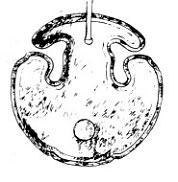yunban overview
 Yunban (pinyin: yun ban) belongs to the percussion instrument category among the body-sounding instruments. It is a percussion instrument of the Dai, Brown, De'ang, Achang and other ethnic groups. In the Dai language, it is called Gan, Lagan, Sister Borrowing, and Delivery. The local Han people call it Yunban, Yunqing, Yunban, and copper bells. Popular in Xishuangbanna, Dehong, Lincang and other areas in Yunnan Province.
Yunban (pinyin: yun ban) belongs to the percussion instrument category among the body-sounding instruments. It is a percussion instrument of the Dai, Brown, De'ang, Achang and other ethnic groups. In the Dai language, it is called Gan, Lagan, Sister Borrowing, and Delivery. The local Han people call it Yunban, Yunqing, Yunban, and copper bells. Popular in Xishuangbanna, Dehong, Lincang and other areas in Yunnan Province.It is cast from bronze and is an isosceles triangular plate shaped like a flat fish head or a flattened felt hat.
It is mainly used as a Theravada Buddhist instrument for Buddhist activities. The big ones are hung in the Buddhist hall, and every time the scriptures are opened, chanted, terminated, and closed, etc., they must be tapped several times; in the ceremony of opening and closing the altar, the big rhyme board is the leading musical instrument, and then the drum and the busy. , cymbals, conch, etc. can be heard in unison. When monks live, eat, and go up and down the Buddhist temple, they should also be tapped as a signal. When not in use, tie it to the inner pillar of the Buddhist hall. Small rhyme boards are used on occasions such as when the Buddha is on the street, entering villages, etc. The little monk accompanies him while walking and hitting, to signal the women on the road to quickly avoid it. The novice also taps the small rhyme board as a signal when making alms. Yunban is only used in Buddhist monasteries.
- Classification:body music
- Dai language:Dare, Lagan, Sister Borrow, Deliver
- Han nationality:Yun board, cloud chime, cloud board, copper bell, etc.
- popular area:Xishuangbanna, Dehong, Lincang, etc., Yunnan Province
- musical instrument construction:Bronze cast, isosceles triangular plate
- pinyin:Yùn bǎn
overview of other similar instruments
- sanyanxiao overview
- Daguangxian overview
- Leiqin overview
- hahao overview
- yandundagu overview
- Han Xiaozheng overview
- Fang Xiang overview
- guanzi overview
- zhuqin (Dao Qin) overview
- zhuiqin overview
- bangzi overview
- three-stringed piano overview
- Gehu overview
- xiao overview
- xiaokonghou overview
- Konghou overview
- Sheng overview
- suona overview
- hulusi overview
- gushao overview
 渝公网安备 50010702504639号
渝公网安备 50010702504639号